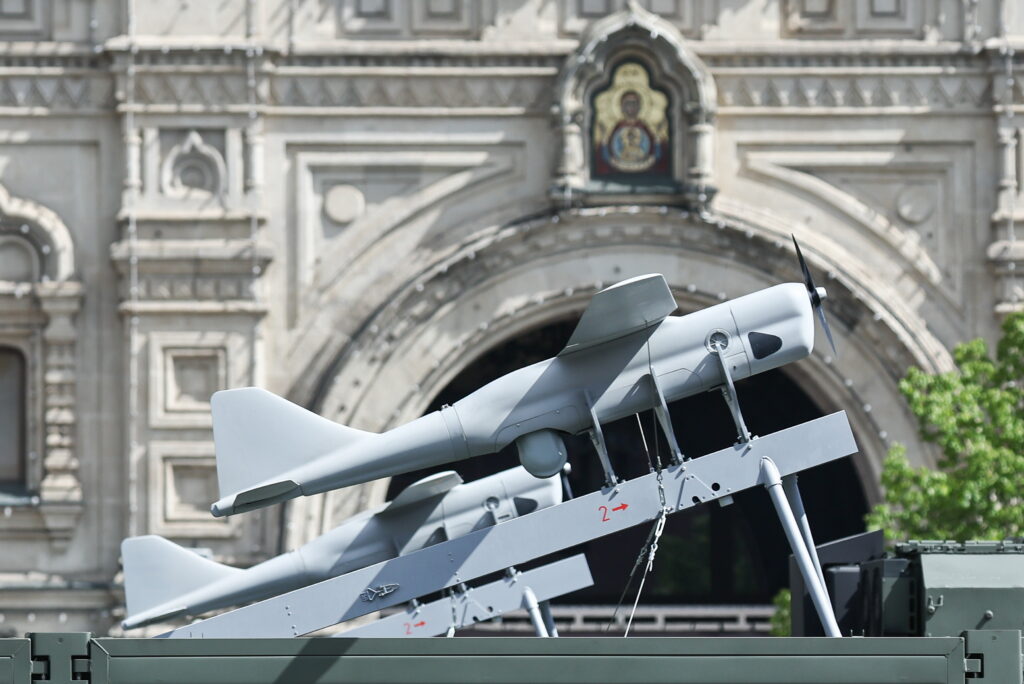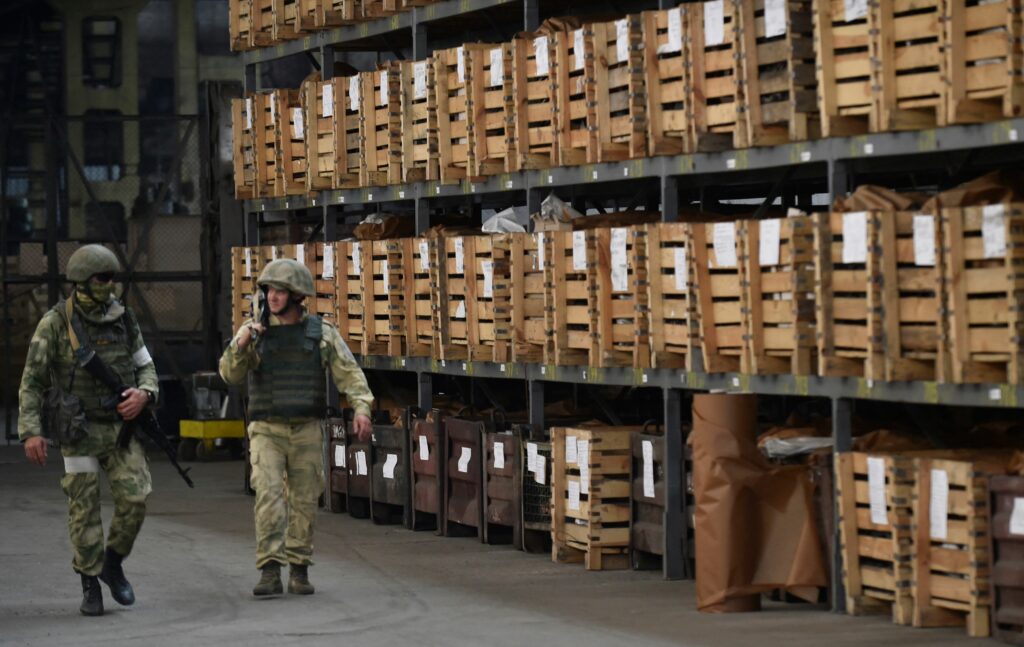The Kremlin has become a hostage to its 2014 annexation of Crimea. Since that time, it has had to spend huge resources on the peninsula. And not least on its military presence there. The Kremlin has spent at least 7 billion US dollars already on the deployment and rearmament of its fleet and military troops in Crimea.
The nature of this military spending in itself reflects wider strategic priorities. By looking at the spending breakdown, it is clear that the Kremlin is fearful of another intervention like that of Iraq or Yugoslavia.
There is also a more general purpose. Militarising Crimea helps to shape perceptions. It is about convincing the world of the peninsula’s vital strategic importance to Russia. The reality this shields is that its capture is far more important to the country’s rulers than to the country itself.
The military versus civil spending
Russia’s economy has been under pressure for the last few years, a direct result of its domestic and foreign policies. In this context, a high dose of direct government spending in the Crimea does not seem too significant at first glance.
After all, the wider picture of Russia’s post-Crimean struggles is quite clear anyway. Foreign direct investments (FDI) in the country have been at rock bottom over the last few years. FDI fell from USD 53.4 billion in 2013 to USD 27.9 billion in 2017. The lowest FDI figure was in 2015, with USD 11.9 billion. Up to 70% of these figures were only pseudo-foreign investments.
This leaves countless projects starved for capital and struggling for growth. Yet political goals and objectives are much more important for the Russian authorities. Besides, economic investment and growth and restored international reputations will have an effect. But probably somewhere beyond the planning timescale of Kremlin policy makers. So such improvements would be useless to them personally. This is exactly why they are ready to spend whatever remaining resources there are on the Crimea, no matter if it is reasonable or not. It is about the peninsula at least becoming a symbolic success.
By the end of 2018, Moscow’s civil expenditures on federal programmes and various subsidies for the Crimea will exceed 1 trillion roubles. That is, nearly USD 20 billion at average annual exchange rates. This amount equals 10 annual budgets of Perm Krai. As it happens, Perm Krai has a population comparable to that of the Crimea (2.5 million people). This spending figure also makes a sizeable omission. That is, several hundred billion roubles spent on the Crimea from the Pension Fund and the Social Insurance Fund in 2014–2018.
The costs of defence and security of the captured Crimean peninsula can be calculated only in some approximation. But even so, the top-line sums are vast:
- Three patrol ships (frigates) of the Admiral Grigorovich type (Project 11356): 40 billion roubles (up to USD 1 billion);
- Six Varshavyanka type submarines (Project 636, Kilo-class): 60–70 billion roubles (up to USD 1.8 billion);
- Two regiments of the S-400 air defence/missile defence system: up to 150 billion roubles (up to USD 2.5 billion);
- Voronezh-SM radar station (under construction): approx. 4–5 billion roubles (USD 80 million);
- Three squadrons of Ka-52, Mi-28N and Mi-35 combat helicopters: up to 30 billion roubles (USD 500–600 million);
- 12 Su-30SM fighters: over than 22 billion roubles (up to USD 400 million);
- Divisions of Bal and Bastion coastal missile systems: up to 18 billion roubles (up to USD 300 million);
- Three border patrol ships of the Izumrud type (Project 22460) for the Federal Security Bureau (FSB): 7.2 billion roubles (up to USD 130 million);
- The Balaklava border patrol ship (Project 10410) for the FSB: 1.35 billion roubles (USD 20 million);
- At least 7,500 flats for military personnel and several hundred flats for the siloviki (security forces): more than 14 billion roubles (over USD 200 million).
Even with the most superficial calculation, it turns out that in 2014–2018 Russia will spend nearly 350 billion roubles (almost USD 7 billion) on defence and security in Crimea. This figure does not include the daily expenses for the maintenance of military troops (20–25 thousand people) and other siloviki, their equipment (from armoured cars to boats), the ongoing modernisation of the RT-70 radio telescope in Yevpatoria for military purposes, investments in other military infrastructure, public procurement orders in Crimean factories, etc.
At the same time, there does not seem to be a plan for any essential strengthening of the forces deployed on the Crimean peninsula in the foreseeable future. Moscow will supply new equipment to the existing military units, finish the ongoing projects and continue to spend money to sustain them.
One should not be reassured by the fact that for one rouble spent for defence and security there are three to four roubles civil expenditures in the Crimea. In fact, such civil expenses are aimed at buying loyalty. Mostly this will be channeled people on the ground who are close to the Kremlin, top officials and even ordinary Crimeans. Such expenditures have exclusively domestic political significance. They are not aimed at turning the peninsula into a showcase of Russian authoritarianism that would look attractive to the rest of the world. The only expenditures in the occupied peninsula tied to Russia’s foreign policy planning are the military ones.
Strategic opportunism
The Crimea or, rather, the troops and the fleet deployed there, have traditionally played the role of a bridgehead. This was for Russian/Soviet offensive operations in the Eastern Mediterranean and on the southern flank of Europe. In the 1990s and 2000s, this function lost its relevance. The Russian base in the Crimea was relegeted a political tool in relations with Ukraine. It became increasingly obvious that the Black Sea Fleet was not needed on the peninsula to ensure Russia’s security. Even the so-called ‘Syrian Express’, i.e. the supply of the Russian grouping in Syria since 2015, was activated (and still is) mainly from Novorossiysk (Krasnodarski Krai).
Yet annexation gave a new meaning to the presence of Russian forces in the Crimea. The creation of a ‘no access zone’ (A2/AD) on and around the peninsula suggests that the Kremlin has learnt from recent history. Military planners have spotted what links the failures of dictators in recent years: the inability to repel air power. Saddam Hussein, Slobodan Milosevic, Muammar Gaddafi all discovered that too late. By and large, the Crimean grouping of forces is primarily intended for defence, and as such, the results of the annexation.
In this regard, another problem arises. How to use the captured peninsula as a bridgehead for constant pressure on Russia’s neighbours around the Black Sea? All neighbours except Turkey, that is. Frigates and submarines placed in Crimea and armed with cruise missiles help to fulfil this task. The pressure on Ukraine, Georgia and even Moldova is direct. Here, is vitally important for the Kremlin to prevent the emergence of successful and steadily developing countries. A high standard of living in the post-Soviet space could rival Russia’s model for development and cause too many questions at home.
The pressure on Bulgaria and Romania is indirect. Moscow does not create an immediate threat. But neither does Moscow want these countries to feel completely safe. It can derive benefits if it manages to sow discord between these countries and other EU and NATO members.
As for Turkey, Moscow does not exert pressure. In fact, it is eager to forge a special relationship with Erdogan’s regime. At present, Russia is content to let a widening rift form between Turkey and its NATO allies.
Ships and submarines sent to the Crimea after the annexation can potentially play an expansive role. But only to a point. This is evidenced by the nature of the actions and the exercises of the Black Sea Fleet. This is not about a direct clash with NATO: Russia is not ready for this in the Mediterranean Sea and never will be. This is about situation-focused, step-by-step intervention in international crisis situations. The aim is to make sure that no one can ignore Moscow.
The presence of a military base in the Crimea is not essential for pressurising neighbours. Neither is it a sine qua non for using force anywhere in the Mediterranean. But it is important for the Kremlin to demonstrate to the whole world that the annexed peninsula is vitally important for Russia. As long as the warships stationed there can make stops in the ports of the EU countries, the Russian authorities will hope that it will be able, in the long run, to push the recognition of the annexation if not by the entire international community, then by an essential part of countries.










